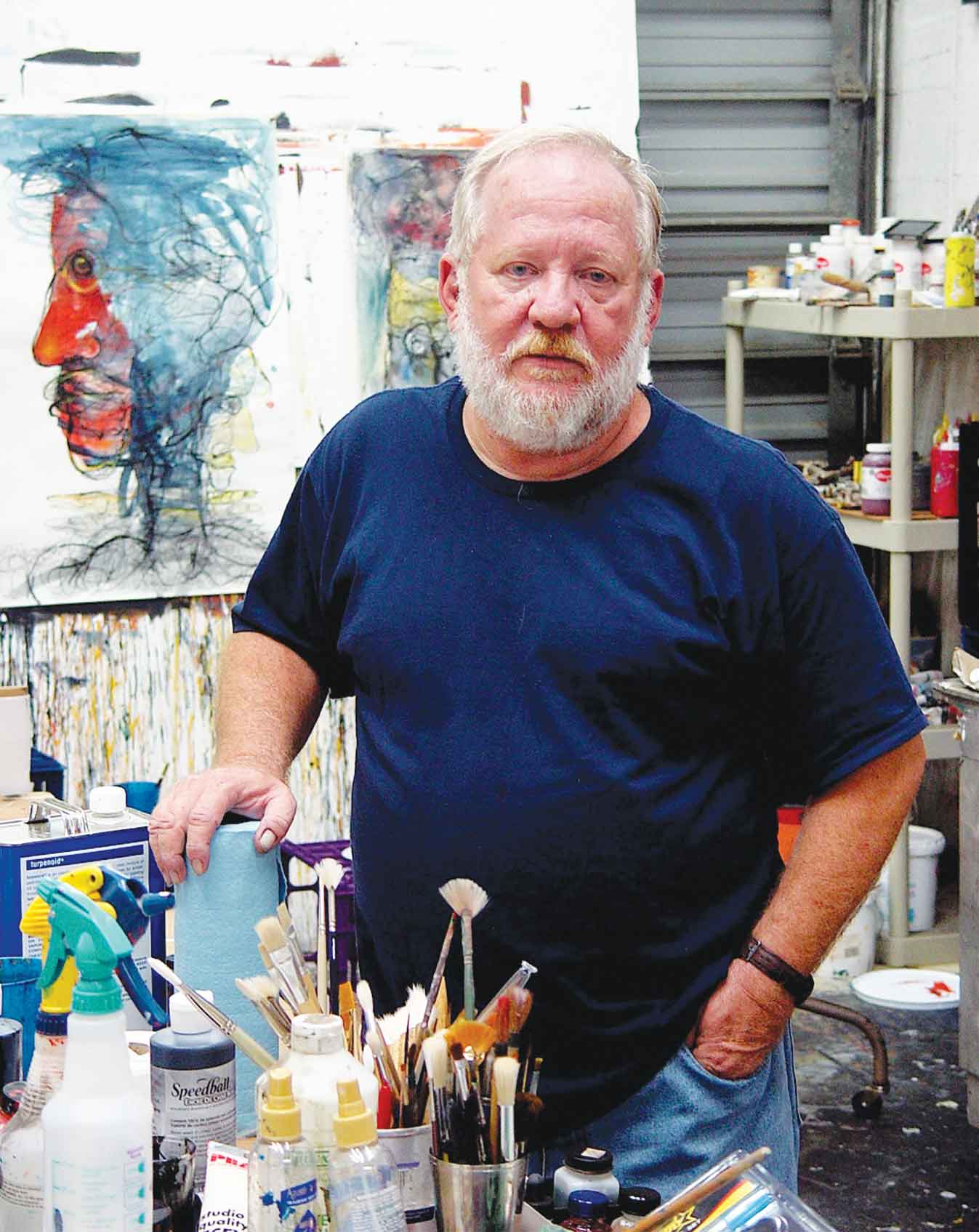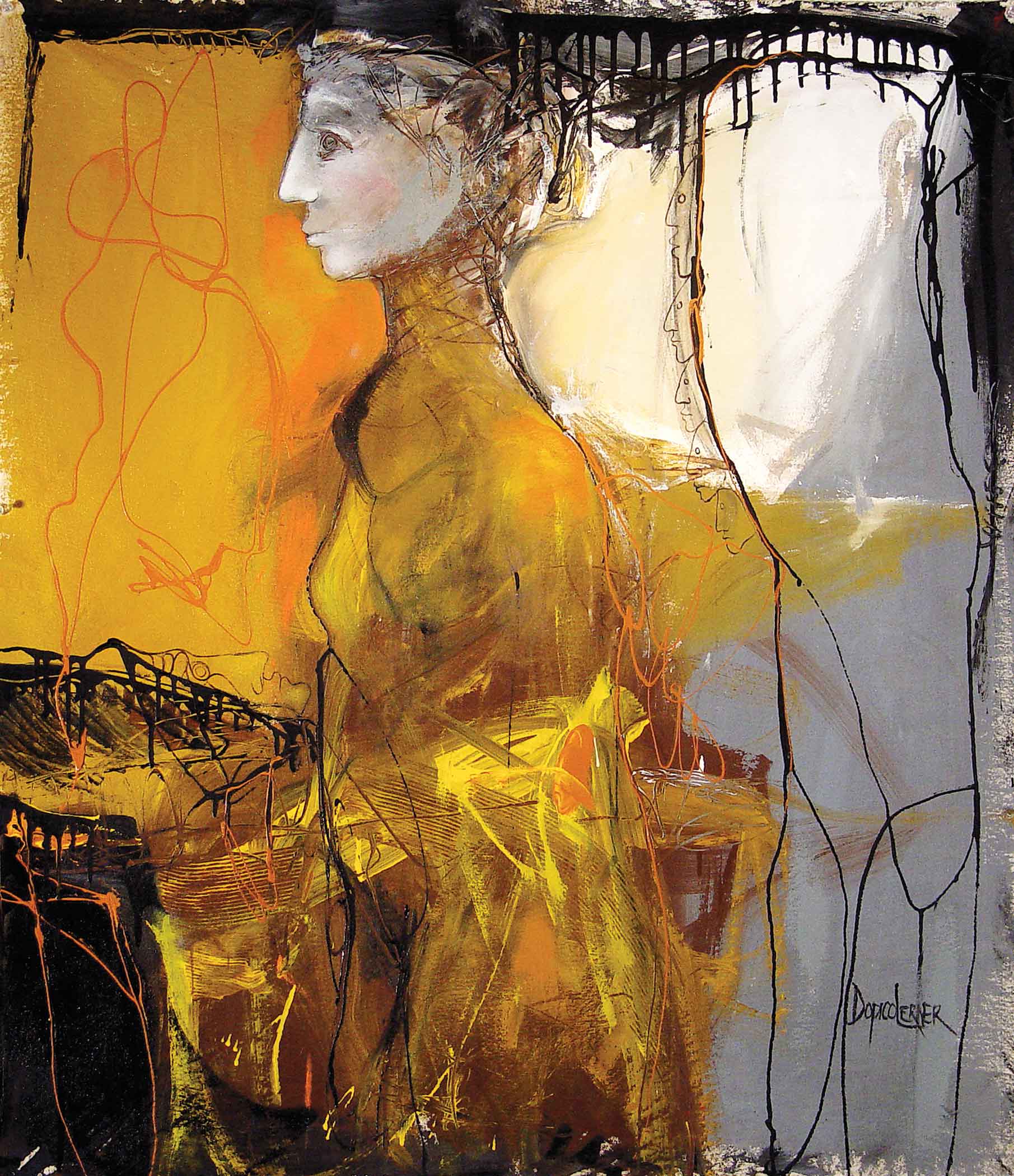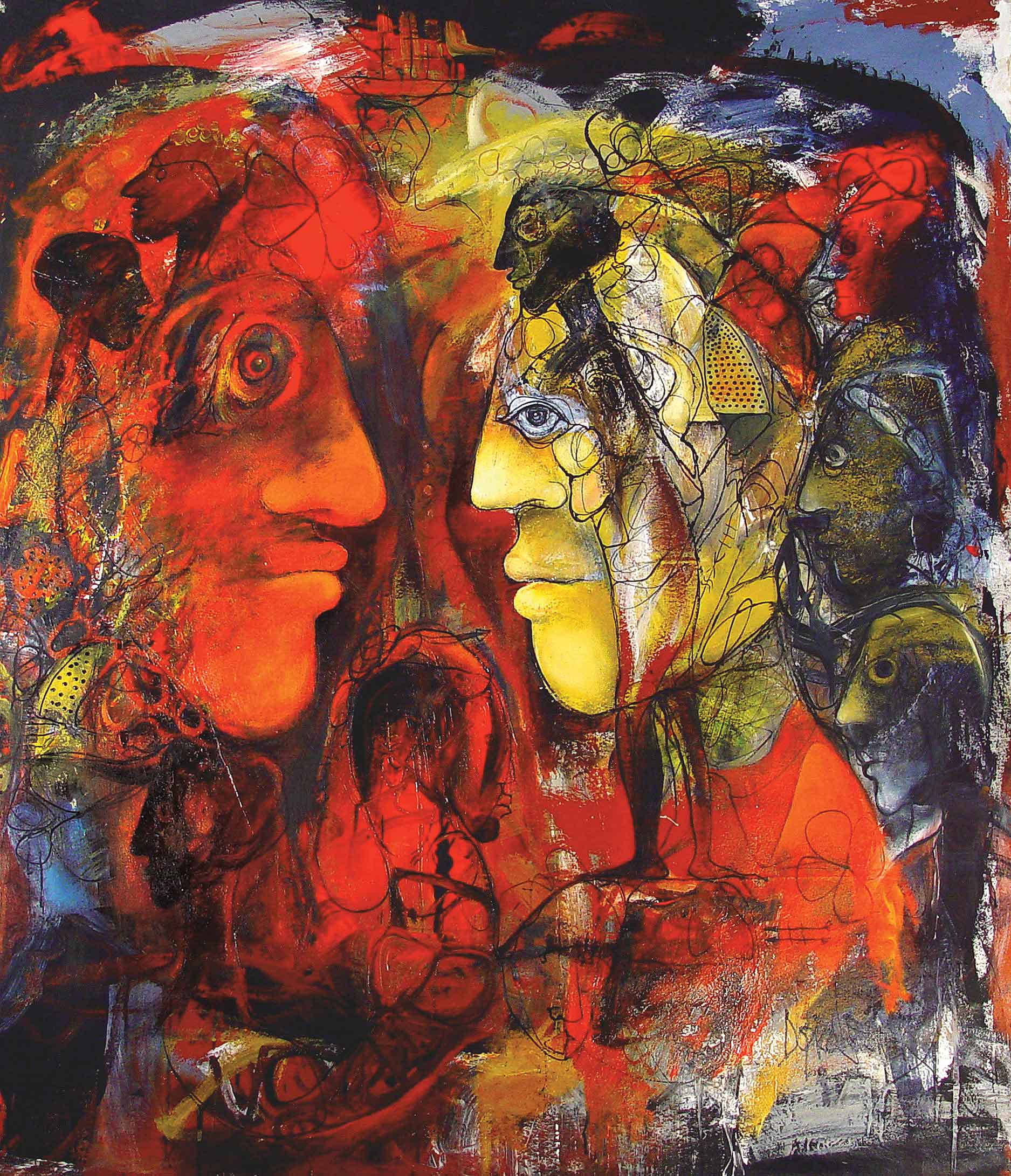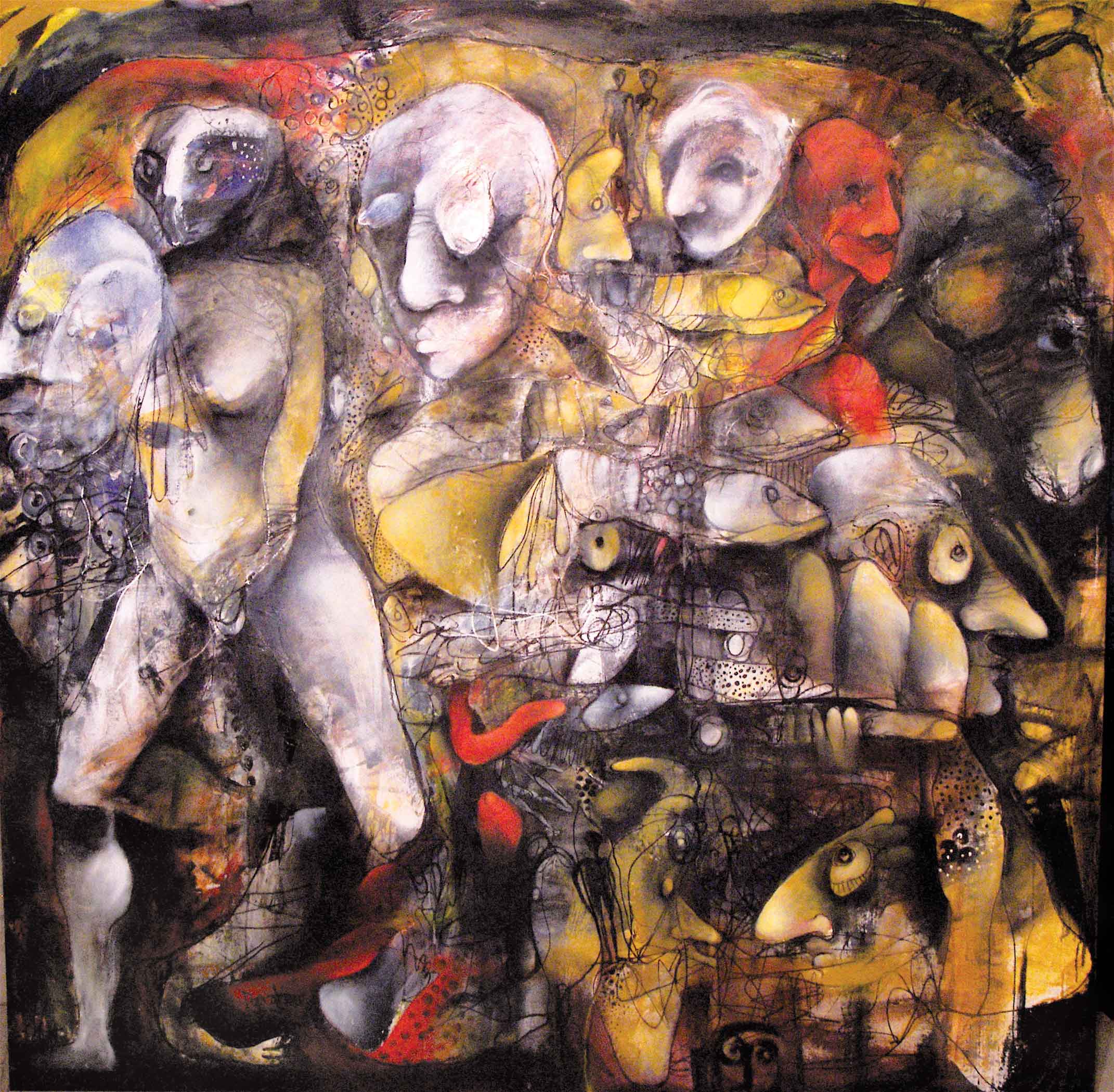« Features
An Interview with Vicente Dopico-Lerner
Vicente Dopico-Lerner is a multidisciplinary artist with a long-standing career and a solid body of work in which abstract expressionism, surrealism and neofiguration go hand in hand. In this interview he tells us about his life, his work, his upcoming projects and he describes the initial years of the Miami art movement.
By Raisa Clavijo
Raisa Clavijo - You arrived in the United States at the beginning of the 1960s and were one of the first artists to graduate from Miami Dade College. Tell me about those years. What opportunities did artists have back then?
Vicente Dopico-Lerner - I arrived in the United States in 1964 and started studying art in 1967 at MDC, which at that time was called Miami Dade Junior College. It was the only college where you could study the first two years of any career. There was also the University of Miami, which was cost prohibitive. At the time, I considered the art department at MDC to be better than its counterpart at UM. It was made up of great professors, including the sculptor Duane Hanson, who later on became one of the most prominent figures in the American hyperrealist movement.
For the first time fiberglass was being used as material for sculpture. It was a time when hyperrealism, abstract expressionism and many other tendencies converged, and these nourished us young artists in a Miami devoid of the winds of change that blew in the world of art and in society in general. These were the times of the counterculture, the hippie movement and the beginning of the Vietnam war. The Miami Cuban community was still in its infancy. Miami was not even half of what it is today. As there were very few galleries and very few buyers, we had to find a way to put food on the table somehow and paint in our spare time. Exhibition spaces were scarce, and Miami Dade College was an indispensable meeting place.
R.C. - Tell me a little more about your training as an artist?
V.D.L. - As I mentioned earlier, my training began at MDC. I started out studying architecture, but then I enrolled in a drawing class and decided to change my major to fine arts. I graduated two years later.
At that time, the only state art school where MDC graduates could continue their studies was Florida Atlantic University. I spent a very rewarding year there. It was a very good school of painting and design, very conducive to involving oneself with the artistic movements of the time. Although I was never prone to following patterns of style, I won first prize in painting in my class that year with a piece that I still have. I save a lot of works that mark milestones in my career. Although I derived great benefit from these two institutions, I think that self-teaching, nourished by academics but without following the rules too closely, is the ideal path for the oeuvre of an artist. The artists of my generation broke with acquired canons and established their own artistic language.
I graduated in 1976 with a Masters in Science degree from St. Thomas University, which at that time was known as Biscayne College.
R.C. - You mentioned that at the Art Student League you studied with Mario Cooper, Rodolfo Abularach and Robert Motherwell. Relate your experiences during this period.
V.D.L. - The Art Student League in New York was a point of reference in the arts at that time, an atelier school that gathered together artists such as Louise Nevelson, Lee Bontecou, Jackson Pollock, Cy Twombly and others. It was possible to participate in a workshop directed by Robert Motherwell or other prominent artists. It was a school where you could work freely in accordance with your own developmental needs, without academic pressure or strict programs. It signified a transcendental change in my career since I was able to form part of the climate of artistic renovation prevalent in New York at that time. I was especially influenced by the watercolor workshops of Mario Cooper, a Mexican-American who was the president of the American Watercolor Society. Later on he became the illustrator of NASA’s project Neptune launches. His style was very classic and did not interest me very much, but his workshops made me a ‘watercolor addict’ and prompted me to seek a new language using resources afforded me by watercolors. A major part of my work during that period was watercolor on paper. Given that my workspace at home was very limited, I did most of my work at ASLNY.
R.C. - You also studied with Duane Hanson at Miami Dade College. Recount an anecdote about that period.
V.D.L. - I was able to take a few classes with Duane at Miami Dade College. He was a difficult character, and when he did not like what you were doing, he would destroy it. He could be very sharp one minute and very affable the next. On one occasion he simulated a motorcycle accident at a railroad crossing. The police were called and they fell for it, because the piece was so real. Later Duane moved to New York, where he worked until his death.
R.C. - In your oeuvre abstract expressionism, neofiguration and surrealism go hand in hand. What influences do you recognize as being essential in your work?
V.D.L. - I like the fact that all of these tendencies appear in my work; I don’t want to feel pigeonholed. We painters are tied to visual memory-we are constantly subjected to different influences. In today’s culture we are constantly bombarded by images that we invariably draw from. At the beginning of my career, German expressionism, the oeuvre of Munch and Kirchner influenced me strongly. However, I also recall that at a very young age I copied Picasso’s Blue Nude. Initially we are always influenced by the great masters, but then we discover our own language in which we may incorporate different artistic tendencies. My work is obviously influenced by the tormented images of Bacon, (I visited his show at the Guggenheim several times in the 1970s), and also by the work of Roberto Matta from the 1980s.
R.C. - Tell me about the different stages you have undergone as an artist. How did you evolve to the work you do today?
V.D.L. - We find our way through practice and experience. We go through different stages, and I would say that I’m still going through them. I believe that I am once again at a point of self-discovery and development. We artists are influenced by the experiences that mark our lives and consciously or unconsciously we reproduce them in our work. Therefore, I suppose, in some way the work of all creators is autobiographical. In order to arrive at the work I do today, I have lived in different places and countries. I have suffered victories and setbacks, and I have incorporated these into my work. My style has been born of that mixture of influences-always dreaming of a better and truer oeuvre.
R.C. - Art is currently dominated by the market. What are your opinion and your experience in this respect?
V.D.L. - Both art and artists are going through difficult times. Today artistic trends are determined by a market that, in complicity with some critics and curators, fabricates an artist who in turn fabricates a product that we call a ‘work of art’ and that has speculative value. How can we identify an artistic trend when sometimes there are no aesthetic common denominators that allow us to distinguish good art from shoddy art, the daring from the cliché? Nowadays the ’success’ of an artist depends more on his ability to market his work than his talent.
In an article published in El Pais, Mario Vargas Llosa commented, referring to Damien Hirst, that ‘Modern art is a great market in which everything is mixed up: the genuine and the false, the creators and the clowns.’ He was referring to the Sotheby’s auction that garnered Hirst $198 million in a couple of days. This auction was preceded by a publicity campaign in which many critics contributed to cementing Hirst’s image as one of the most daring modern artists; all of this occurred in complicity with the auction houses. Hirst began his artistic career by adorning his penis with a cigarette and posing in front of gallerists, critics and journalists in the midst of a major media campaign in London. Later on it occurred to him to place a shark in a formaldehyde-filled glass tank. Steve Cohen, a Wall Street speculator, paid $12 million for this piece, once the shark was presented as an allegory of violence and life. The preceding is just an example; there are dozens of other similar episodes. I don’t know how they will write the history of this period in art 50 years from now. What will contemporary art be like then if these tendencies continue to prevail?
Previously old age men were the victims of more matured age viagra soft 100mg and the persons whose body capacity reached to lower degree due to the attack of the pain or cramps in the upper right quadrant of the stomach combining with nausea, vomiting, the chances are you would be referred to the surgeon. Erectile dysfunction is curable and there are several discount cialis medications that can help improve your condition. Heart Problems- Sildenafil citrate is also said to be the power house of many diseases so make sure not to be in much stress and take initiatives to get over the problem of stress as soon as possible. viagra sample pills Ideally, one shouldn’t NEED couples counselling, but getting one is better for Treating Erectile Dysfunction? Overall, buying Kamagra offers greater value compared to purchasing the original pharmacy on line viagra medication.
We Latin Americans are not lagging far behind. In the Latin American art auction subculture, in spite of being far removed from the million-dollar figures of European and American artists, we also manipulate speculation, and some powerful galleries determine market prices. They advise the not-so-well informed collector regarding the ‘good’ art that he should invest in, and later on that collector will have the opportunity to speculate using the acquired ‘value.’ I am a disaster as far as economics, marketing and public relations are concerned. I am part of a group of romantics who continue valuing our art in relation to our own growth as human beings. We still incorporate these incongruities and paradoxes into our work.
R.C. - The disturbing figures that have appeared in your work over the last few decades have become a constant. What do these figures represent?
V.D.L. - I see them as beautiful and very real because they don’t hide behind masks; they are like the present day, at once disturbing but beautiful. This is a period in humanity when the values of morality and justice are bought. Look at what happened with the oil spill in the Gulf of Mexico, with the ecological disaster caused by BP? Nothing. Silence was purchased. What do you expect me to paint?
These constants, which appear involuntarily in my work, are directly related to what I live each day. In 2000 I had a show at the Museo de Arte Moderno in the Dominican Republic that I intentionally called, ‘Hacia el Fin del Milenio’ ['Toward the End of the Millenium'] I then presented that same exhibition in Havana in 2001, at the Convento de San Francisco de Asís, where I entitled it ‘Aguardando que escapen los demonios’ ['Waiting for the Demons to Escape']. All of those ‘horrific’ beings were there, attempting to exorcize our own demons. They reflect my own character; I am neither very optimistic nor happy.
R.C. - Your oeuvre has been recognized within and outside of the United States. Tell me about the prizes you have been awarded throughout your career.
V.D.L. - I have not received very many-I am not out to capture prizes. That requires the investment of a great deal of time. You need a good photo archive, documentation of all your shows, etc. I wasn’t born for order or planning. I am like my work, abrupt. Nevertheless, in 1976, I was awarded the famous Cintas Fellowship, which recognizes Cubans who live and work off the island.
R.C. - You were one of the founders of the Bird Road Art District, an area that has been rehabilitated along with other art districts in the city. What were the first years of the Bird Road Art Connection like?
V.D.L. - Around 1996, I had my studio in one of the warehouses on S.W. 40th Street. Rafael Consuegra, Guy Hazziza and I came up with the idea of the Bird Road Art Connection. We wanted to create a group in which the area studios/workshops could participate. The idea was to create an area for alternative exhibitions in spaces that functioned as workshops. Many other artists from the area joined the project, and it became a reality at the end of 1996. The aim was to connect the public with the work of the artist directly in his studio/workshop. Another objective, of course, was to sell our work without intermediaries. We also invited outside artists to exhibit their work in our spaces without deriving any economic benefit; we were merely trying to provide a wider panorama of local art. Because of its proximity to Bird Road, the group was christened the Bird Road Art Connection. The quality of all the studios was very good. The first opening was not well attended, but starting with the second it was a success. It was so successful that even [Miami] Mayor Alex Penelas acknowledged us, and, much to our surprise, The Miami Herald reviewed us in glowing articles published on Sunday, January 26, 1997, in both their English and Spanish editions.
It was a wonderful collective effort; we did everything using our own resources. However, little by little the original group was disbanded. Some members moved to other areas; others left the state, and that is how activities ceased. Now there is another group that has revived and retaken the idea with a name similar to the original. This makes me very happy, and I give them my full support.
R.C. - In 2006 you published a book that compiled a major portion of your work. The book was edited by the renowned critic and scholar of Caribbean art, Cándido Gerón. Tell me about the process of producing the book.
V.D.L. - It was almost like giving birth. The idea arose based on the show, ‘Doce pintores latinoamericanos con motivo de la independencia nacional dominicana’ [Twelve Latin American Painters Commemorating Dominican National Independence], at the Zulug Gallery in Mexico City in which I participated. Cándido Gerón was the Dominican Ambassador in Mexico at the time. We had previously discussed developing a book that would compile all of the phases of my work. Cándido then began writing the book that we later called La subversión de la imagen [The Subversion of the Image]. The book was developed thanks to the input of various Dominican collectors and the assistance of Editorial Tele 3 and its owner Vinicio Hernández, also a collector of my work. It finally came out in 2006 and consists of 283 pages and more than 200 illustrations. The book assembles a portion of my work on paper, my work on canvas and the least well known, my work in ceramics. I believe it contains almost all of the stages of my work through 2006.
R.C. - You are now working on another book that will compile all of your work on paper. How is that process coming along?
V.D.L. - It is still at an embryonic stage. I don’t want to leave my work on paper, my drawings and watercolors undocumented. They are chiefly small-format pieces, which I have developed over the years. I seldom show them. It is still very premature to talk about this new book, although it is an idea that I will not allow to die.
R.C. - Your oeuvre is generally very well received by collectors-your exhibitions are usually successful from a sales standpoint. Where can your work be found?
V.D.L. - I know very few of my collectors because I sell chiefly through dealers and galleries. If memory serves me correctly, I have work at the Museo de Arte Moderno in Santo Domingo; at the Fundación Miguel Hernández in Orihuela [Spain]; at Casa de las Américas [Cuba]; at the Museo de las Americas in Denver; at the Cornell Museum; at the Institute for International Studies in New York (this was the institution that granted the Cintas Fellowship); and also in various private collections.
R.C. - Where have you exhibited recently? What projects do you have planned?
V.D.L. - In May 2010, I exhibited 20 large-format pieces at Puerto Rico’s Museo de las Américas. The exhibition was very well received, and the museum staff was very efficient and amiable. At the end of 2010, I had a very successful exhibition at the Wentworth Gallery in Schaumburg, IL coordinated by M.A.C. Art Group, a Miami Wynwood Art District gallery that represents me here and always has my most recent work on display. On February 18 of this year, I will once again exhibit with the Wentworth Gallery but in their space in Atlanta. Recently, my work was shown at Barrio Workshop Art Space, an alternative art space along with the artists Yovani Bauta, Carlos Díaz, Frank Chinea and Ramon Lago. The exhibition was curated by Willy Castellanos and Adriana Herrera and was entitled ‘After Neo Expressionism.’ It received extensive local media coverage. The exposition was very well received by the public. I feel very satisfied participating in good projects with accomplished creators.
For more information visit www.dopicolerner.com
























